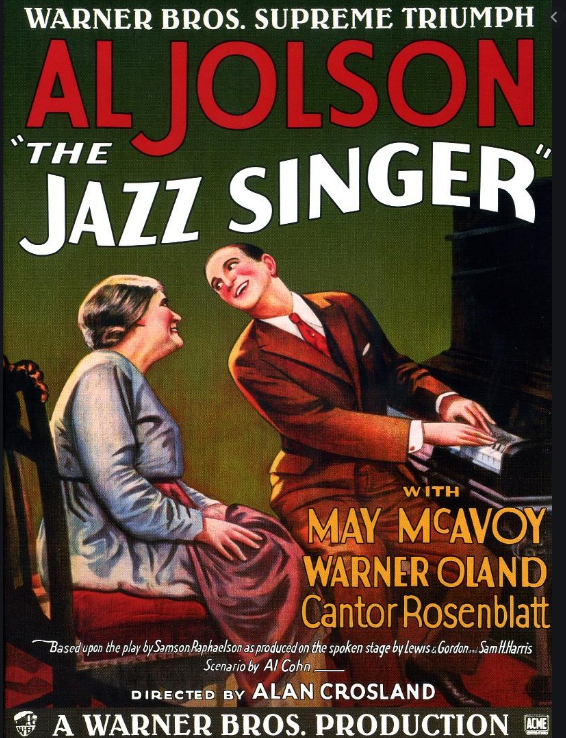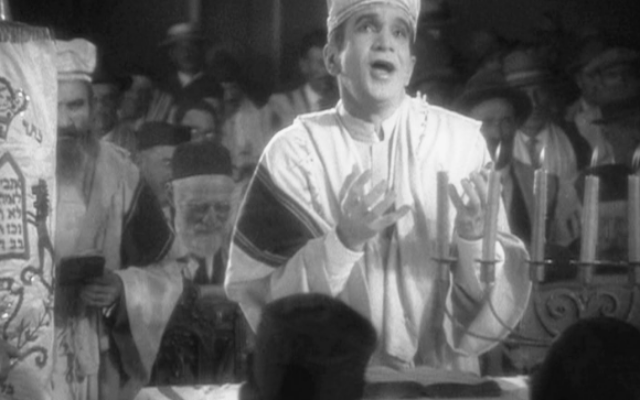‘The Jazz Singer’ Celebrates Yom Kippur
Film introduced the sound of Jewish prayer to American film audiences.
Just after the end of the Yom Kippur holiday in 1927, Warner Bros. launched what would become the most famous Hollywood film to feature the Day of Atonement.
The film “The Jazz Singer,” which premiered almost 93 years ago on October 6, starred Al Jolson as Jakie Rabinowitz, the son of a cantor in New York who forsakes the religious life for a career in show business as the jazz singer Jack Robin.
In the film, the Yom Kippur holiday neatly brackets the 20-year history that the story covers. First, when the young teenager Jakie is found performing in a local tavern on Yom Kippur Eve and rebukes his father.
“You’re of the old world! If you were born here, you’d feel the same as I do … tradition is all right but this is another day. I’ll live my life as I see fit.”
Later near the end of the film, when Jack Robin returns home on the eve of the holiday as a successful performer to visit his terminally ill father, his attitude softens. At the climax to the drama he agrees to return to the synagogue to perform the “Kol Nidre” prayer.
While the film effectively tells a familiar story of the conflict between obedience to traditional religious life and the lure of the modern world, “The Jazz Singer” would have been forgotten long ago if not for the fact that it features the first spoken dialogue ever heard in a featured film.
Three quarters of the film is silent. But in one of the most famous scenes in film history, Jolson, as a rising star on the Broadway stage, visits his mother to speak on the screen loudly and clearly of his success and the new show he is rehearsing.

The dialogue was said by some to have been made up on the spot, with the words just tumbling from an exuberant Jolson as they occurred to him. But for an audience that had been accustomed to silence on the screen, Jolson’s spoken monologue was electrifying.
“Mama, darlin’, if I’m a success in this show, well, we’re gonna move from here. Oh yes, we’re gonna move up in the Bronx.
“A lot of nice green grass up there and a whole lot of people you know. There’s the Ginsbergs, the Guttenbergs, and the Goldbergs. Oh, a whole lotta Bergs, I don’t know ’em all.
“And I’m gonna buy you a nice black silk dress, Mama. You see Mrs. Friedman, the butcher’s wife, she’ll be jealous of you … Yes, she will. You see if she isn’t. And I’m gonna get you a nice pink dress that’ll go with your brown eyes …”
With Jolson rattling on about “a whole lotta Bergs,” Jolson was giving voice to not only a new era of sound on the screen, but to some of the dilemmas that American Jews were beginning to face as immigrants in America. They were, in 1927, beginning to see the results that hard work and the drive to succeed were starting to have.
The film is a rare examination by early Hollywood’s Jewish moguls of the conflict that this brought.
The story of “The Jazz Singer” largely parallels Jolson’s own life as an immigrant from Lithuania, who turns his back on his father, a cantor, and achieves success as one of the greatest stars of his era.
The year after “The Jazz Singer” opened, Jolson married another prominent performer, Ruby Keeler, who was not Jewish. He was said to return to the synagogue only on his mother’s yahrzeit, the anniversary of her death.

In the film he comes home on Yom Kippur eve just before his new show is set to open on Broadway. His father is too ill to perform his cantorial responsibilities and Jack is asked to take his place. The dilemma is clear and dramatic, if he chooses the “Kol Nidre” over the Broadway opening, his career could be over.
But the thought of disappointing a father on his deathbed wins him over and Jolson, in the traditional white robes, sings the Hebrew words of the traditional prayer flanked by a pair of the congregation’s Torah scrolls.
The film was a smash hit and audiences in towns and cities across America who had never seen a Jew or had ever been inside a synagogue suddenly were introduced to both. Warner Bros. even produced a small booklet for audiences with a vocabulary of Yiddish words and their meanings that were used in the film.
The success of the film ushered in an entirely new era in entertainment. Within two years of its premiere in 1927, nearly every theater in America had been wired for sound. But rarely have the words of Hebrew prayer been heard with such impact as they were over 90 years ago.



comments